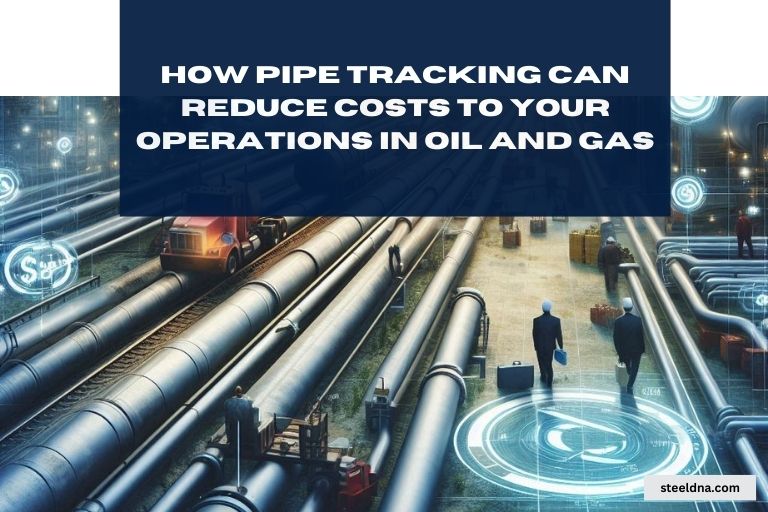Introduction
Efficient pipe tracking is a critical component that can significantly impact operations in the oil and gas industry. The methods used for this purpose vary, with two primary approaches taking the lead: manual and automated tracking systems. Each method has its own set of advantages and drawbacks, and selecting the right one, or a combination of approaches, is pivotal for ensuring accuracy, productivity, and cost-effectiveness in the management of pipelines. In this blog post, we delve into the comparison between manual and automated pipe tracking, examining the intricacies of each approach and shedding light on the factors that should guide industry professionals in making informed decisions tailored to their specific needs.
Manual Pipe Tracking
- Explanation of traditional manual tracking processes- Traditional manual pipe tracking involves relying on spreadsheets and documentation to monitor the movement and location of pipes within the oil and gas industry. Employees manually record data, including pipe specifications, locations, and maintenance history. This method has been a longstanding practice due to its simplicity and familiarity within the industry.
- Advantages and disadvantages- The manual approach offers a degree of flexibility and is easy to implement, as it leverages familiar tools like spreadsheets. However, its labor-intensive nature makes it susceptible to human errors, potentially leading to inaccuracies in the tracking process. The manual method may require additional time and effort, impacting overall efficiency and the ability to respond promptly to changes in the pipeline system.
Automated Pipe Tracking
- Overview of automated tracking systems- Automated pipe tracking systems represent a modern approach to efficiently manage and monitor pipelines. These systems utilize technologies such as RFID and sensors, coupled with integration with digital platforms and software. By automating the tracking process, these systems aim to provide real-time data and streamline the management of pipelines.
- Advantages and disadvantages- Automated pipe tracking offers increased accuracy and efficiency by reducing reliance on manual data entry. Real-time tracking capabilities enable quick response to changes in the pipeline system. However, the initial investment required for implementing automated systems and the potential learning curve associated with new technologies may pose challenges for some organizations. The long-term benefits, such as improved accuracy and operational efficiency, often outweigh these initial hurdles.
Comparing the Two Approaches
- Accuracy and Precision- In manual pipe tracking, human involvement introduces the potential for errors, as reliance on spreadsheets and documentation can lead to inaccuracies. Automated pipe tracking, on the other hand, employs RFID technology and sensors to provide real-time, precise data. The automated systems significantly reduce the margin of error, ensuring that the information about pipe location and status is consistently accurate. This increased accuracy not only enhances operational efficiency but also contributes to better decision-making processes.
- Efficiency and Time Savings- Manual tracking processes are often time-consuming, requiring extensive human labor for data acquisition and processing. In contrast, automated pipe tracking systems operate at a faster pace, offering real-time insights into the location and movement of pipes. The efficiency gains are particularly evident in large-scale operations where timely information is crucial. By automating the tracking process, companies can save valuable time, allowing for quicker response to changes and potential issues in the pipeline, ultimately streamlining overall project timelines.
- Cost Considerations- When evaluating manual and automated pipe tracking, cost is a critical factor. Manual tracking may seem cost-effective initially, but the labor-intensive nature and potential for errors can lead to increased operational costs in the long run. Automated tracking systems require an initial investment in technology and training, but they often result in long-term cost savings due to improved efficiency and reduced errors. A careful analysis of the total cost of ownership is essential to determine the most cost-effective solution based on the specific needs and scale of the oil and gas operations.
Choosing the Right Approach
When evaluating the optimal pipe tracking approach, it is crucial to weigh various factors.
- Consider the scale of operations within your organization – larger operations may benefit more from the efficiency gains of automated tracking.
- Additionally, budget constraints play a pivotal role; while automated systems may require an initial investment, the long-term cost savings and accuracy improvements should not be overlooked.
- Integration with existing systems is another critical consideration, ensuring seamless compatibility without disrupting ongoing operations.
Future Trends in Pipe Tracking
- Emerging Technologies in Automated Pipe Tracking- Miniaturized sensors with enhanced capabilities are becoming more affordable and scalable, allowing for widespread implementation. These advancements facilitate real-time monitoring of pipeline conditions, enabling early detection of potential issues and proactive maintenance strategies. The integration of Internet of Things (IoT) devices further enhances connectivity, ensuring a seamless flow of information between different components of the pipeline infrastructure.
- Industry Trends and the Direction of Pipe Tracking Methods- The industry is witnessing a shift towards holistic pipeline management systems that go beyond traditional tracking methods. Integrated solutions, combining automated pipe tracking with other functionalities such as predictive maintenance and risk analysis, are gaining prominence. This trend reflects a broader industry-wide effort to optimize operations and minimize downtime by adopting comprehensive, data-driven approaches to pipeline management. The focus is not only on tracking the physical location of pipes but also on understanding their health and performance in real-time.
- The Role of Artificial Intelligence and Machine Learning- Artificial intelligence (AI) and machine learning (ML) are emerging as game-changers in the field of pipe tracking. These technologies empower systems to learn from historical data, predict potential issues, and adapt to evolving conditions. AI-driven algorithms can analyze vast amounts of data, providing valuable insights into the health and integrity of pipelines. This proactive approach enables operators to make data-informed decisions, enhancing overall efficiency and reducing the risk of unexpected failures. As AI and ML continue to evolve, their integration into pipe tracking systems promises to revolutionize the way the industry manages and safeguards its pipeline infrastructure.
Conclusion
In conclusion, the choice between manual and automated pipe tracking in the oil and gas industry is a pivotal decision that directly influences operational efficiency and accuracy. By examining the advantages and disadvantages of each approach, companies can make informed decisions aligned with their specific needs.
Manual tracking, while offering familiarity and flexibility, tends to be labor-intensive and susceptible to errors. On the other hand, automated pipe tracking systems, leveraging RFID technology and real-time data integration, present a significant leap in accuracy and efficiency, albeit with an initial learning curve and investment.
Looking ahead, the future of pipe tracking is marked by emerging technologies, including advancements in artificial intelligence and machine learning. As the industry continues to evolve, companies should stay abreast of these developments to ensure their chosen tracking method remains aligned with the evolving landscape.
In summary, whether opting for the reliability of manual processes or the precision of automated systems, companies must make strategic decisions that enhance overall operational effectiveness. The key lies in a thoughtful evaluation of individual needs and a proactive stance in adopting technologies that align with the industry's ever-changing demands.
Popular Articles
Expand your knowledge with these insightful blog posts.

The Economic Benefits of Coil Tracking in Oil and Gas

How Pipe Tracking Can Reduce Costs to your Operations in Oil and Gas

Predictive Maintenance with Coil Tracking: Reducing Downtime and Costs
Subscribe to our Blog
Welcome to our blog! Stay updated with the latest industry trends, tips, and insights. Subscribe now to never miss a post or contact us for collaborations and guest post opportunities.
